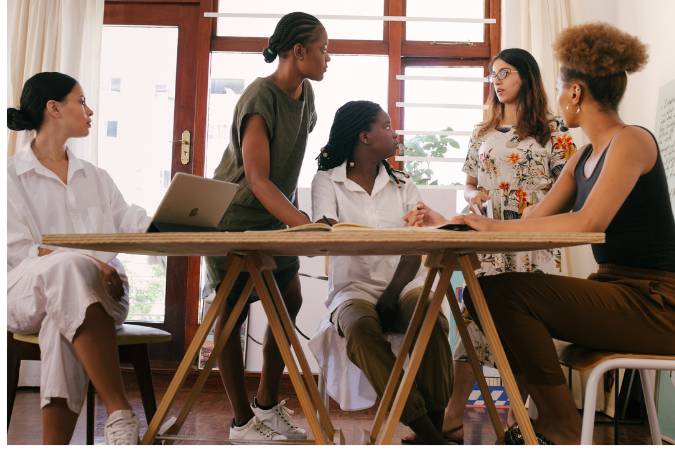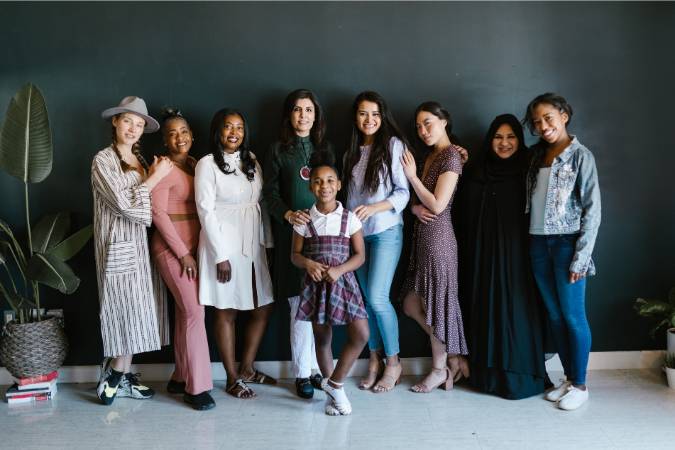Collaboration is Key
Mothers Institute for Collaboration and Art (MICA) is screaming for collaboration. Collaborating is invaluable for artists for innovation, creativity, and community. As we know, parents who are artists have unique circumstances; the caretaking of children takes up your time, to be blunt. When you become a parent, suddenly, you’re responsible for the well-being and future of a vulnerable human life. For most parents, this means you’re looking at the world from a different lens.
Heck, you’ve got neuroplasticity changing up your brain. It also means that whatever life you had created now needs to fit kids into it. So, if you’re an artist, well, finding time to create is even more precious than before.
Balancing the Two Sides of Parent Artists
Getting out of the caretaker’s head and into the artist’s head can be challenging. However, as artists, we must! The world depends on us. Listen, we know collaboration has long been a thing of art, and now, other industries have caught on. By the way, the Washington Post article linked talks about the five things Gen Z wants in the workplace:
1. Customized career paths,
2. Constant opportunities to learn,
3. Purpose-driven work,
4. Flexible work arrangements,
5. Collaborative environments.
Hello? That is exactly what (Gen X) MICA founder Lyza Fennell is all about. Collaborating on projects can be particularly advantageous for parents to balance their creative practice with parenting responsibilities. Finding time to create is a major challenge for parents, with all the obligations that come with parenting today.
The Benefits of Collaboration for Mother Artists
The benefits of collaboration are numerous! Here are a few ways to consider how it can help:
- Providing support and community: artists can feel isolated and alone in their creative journey. Collaboration can give them a supportive community of fellow artists who understand their challenges. Sometimes isolation is good, but not always.
- Reducing time commitments: collaborating with others can help reduce your workload and save time for other important tasks. This is especially helpful if you have limited time to create art.
- Expanding creative possibilities: Collaboration can help mother artists expand their creative possibilities. By bringing in new ideas and perspectives from other artists, you can push the boundaries of your art and create something truly innovative.
In other words, collaboration is a valuable approach that offers several benefits and serves as a support system for artist parents. By working together, these talented individuals can share ideas, resources, and experiences, which can help them overcome the challenges of balancing their creative pursuits and parental responsibilities. Therefore, this collaborative approach can also create a more inclusive environment within the arts community, where everyone can feel supported and empowered to pursue their passions.

The Pathway to Collaboration
Time is precious when you are a parent and artist. There are so many demands on your time, and finding the time to create art can be hard. But collaboration can be a pathway to making art even when you’re busy.
Collaboration can help parent artists overcome the challenges of balancing their creative practice with parenting responsibilities in several ways. For example, collaboration can:
- Overcoming creative blocks: Sometimes, mother artists can get stuck in a creative rut. Collaboration can help them break out of this rut by giving them new ideas and perspectives.
- Learning new skills: Collaboration can be a great way to learn new skills from other artists. This can help mother artists grow as artists and create even more amazing work.
- Building a network: Collaboration can help mother artists build their network of contacts in the art world. This can lead to more opportunities to exhibit and sell their art.
In other words, it is a powerful tool to help artists who are parents overcome the challenges of balancing their creative practice with parenting responsibilities. It’s a great way to gain support and community, reduce time commitments, expand creative possibilities, overcome creative blocks, learn new skills, and build your network.

Types of Collaboration
On-site collaboration: On-site collaborations such as artist residencies and workshops offer a hands-on experience. These immersive programs provide a unique opportunity to work closely with other artists, learn new techniques, and gain inspiration.
Virtual collaboration: In today’s digital age, virtual collaboration is growing increasingly popular. Online platforms allow you to connect with artists from around the world. You could collaborate on a digital art project, host a virtual workshop, or organize an online art exhibition.
Collaboration: A Catalyst for Innovation
Here are some specific examples of how collaboration can benefit mother artists:
Workshopping: Workshops can be a great way for mother artists to learn new skills, share ideas, and get feedback from other artists.
Critique groups: Critique groups can be a supportive and constructive way for mother artists to get feedback on their work.
Weekly meetings: Weekly meetings with other mother artists can provide a much-needed support system and accountability for them trying to balance their creative practice with their parenting responsibilities.
Successful forms of collaboration can lead to a more dynamic and productive environment where different voices and opinions are valued and leveraged for the greater good.
Ultimately, the power of collaboration lies in its ability to bring people together, fostering a sense of community and shared purpose that can drive real change and progress.
Finding the Right Collaborators
Finding the right collaborator can be daunting, but it’s essential for mother artists who want to collaborate effectively. Finding people who share your artistic vision and goals is important when looking for collaborators. You also want to find people who are reliable, hardworking, and easy to get along with.
Here are a few tips for finding the right collaborators:
- Attend art events and join art organizations. This is a great way to meet other artists and learn about their work.
- Reach out to artists whose work you admire. Send them a message or email and introduce yourself.
- Look for collaborators online. There are many websites and online forums where artists can connect with each other.
Once you’ve found a few potential collaborators, getting to know them better is important. Meet up with them in person and talk about your work. This will help you to see if you’re a good fit for each other.
Here are a few questions you can ask potential collaborators:
- What are your artistic goals?
- What are your strengths and weaknesses as an artist?
- What are you looking for in a collaborator?
- How do you like to work?
If you find that you have a good rapport with a potential collaborator and share similar goals, you’re well on your way to a successful collaboration.
Social media platforms like Instagram or Facebook can also be useful tools to connect with other artists around the globe. You can search for hashtags related to your art form or interests and likely find other artists using those hashtags. You can also join groups on social media for artists; this is a great way to connect with other artists interested in collaborating.

Balancing Artistic Endeavors and Parenting
Juggling your artistic pursuits with motherhood can be challenging but not impossible. Here are a few tips for balancing these two important parts of your life:
- Set boundaries. It’s important to set boundaries between your artistic and parenting time. This means setting aside specific times each day or week for your art and sticking to those times as much as possible. It also means not letting your parenting responsibilities seep into your artistic time and vice versa.
- Manage your time effectively. This is essential for any busy parent, but it’s especially important for mother artists who want to make time for their art. Several time management techniques, such as batching tasks and using a planner, can be helpful.
- Ask for help. Don’t be afraid to ask for help from your partner, family, and friends. This can free up some of your time to focus on your art.
In this way, collaboration can help, as shared projects can divide the workload and offer mutual support. Find other mother artists who are also passionate about their art and work on projects together. This can be a great way to get support and feedback, and it can also help you to stay motivated.
Want to Collaborate with Non-Artists?
Artists and non-artists can benefit greatly from collaboration. Artists can bring their creativity and vision to the table, while non-artists can provide expertise in other types of new technologies, processes, and fields of knowledge. This can lead to innovative and exciting new art that would not be possible without collaboration.
Here are some examples of how artists can collaborate with non-artists:
- With technologists and scientists: Artists can collaborate with technologists and scientists to create new and engaging art that uses cutting-edge technology. This could involve creating interactive installations, virtual reality experiences, or augmented reality artworks.
- With educators: Artists can collaborate with educators to create new and engaging art education programs. This could involve developing a new curriculum, leading workshops, or creating interactive art installations.
- With community organizers: Artists can collaborate with community organizers to create art addressing social and environmental issues. This could involve creating murals, public art installations, or theater productions.
- With businesses: Artists can collaborate with businesses to create art promoting their products or services. This could involve designing logos, creating marketing materials, or developing interactive exhibits.
There are many other possibilities for collaboration between artists and non-artists. The key is to be open to new ideas and to think outside the box. By collaborating with others, artists can have a greater impact on the world and make a difference in the lives of others.

Where Do You Find the Collaborators?
Collaboration is essential for mother artists who want to take their art to the next level. By collaborating with other artists, mother artists can share ideas, learn new skills, and get feedback on their work. They can also build a community of support and accountability.
There are many places where mother artists can find collaborators. Here are a few suggestions:
- Online communities: There are many online communities where mother artists can connect with each other and find potential collaborators. Some popular online communities include Meetup, Facebook groups, and Twitter.
- Conferences and workshops: Attending conferences and workshops that bring together professionals from various fields is an excellent way to network with potential collaborators and stay current on the latest technologies and trends.
- Reach out to local organizations: Many local organizations support collaboration between artists. Reaching out to these organizations is a great way to find collaborators in your area.
Finding collaborators can be daunting, but it’s essential for mother artists who want to collaborate effectively. Mother artists can find collaborators who share their artistic vision and goals by following the tips in this section.
It's Time to Get Out There and Collaborate
Collaborating with other artists can greatly enhance your artistic practice. It can broaden your creative range, expose you to different styles and techniques, and provide a platform to share and exchange ideas.
Moreover, it can help you build a network of like-minded individuals who can provide support, feedback, and encouragement.
Remember, your creativity does not have to be a solitary journey. Collaboration can open doors to new possibilities and experiences.
So, step out, reach out, and embrace the power of working together. Your art, your passion, and your creative journey deserve it.
Artist moms, are you ready to take your creativity to the next level? Collaboration is the key to unlocking new ideas, expanding your artistic horizons, and building a supportive community. Comment below, tell us what you’re thinking about or your experiences with collaborations.
Want to Join our Collaborative in Northampton, MA?
Email us or comment below today!
Sources:
“Future World-building Depends on Artists and Collaborative Networks” By Kamal Sinclair; National Endowment for the Arts.

